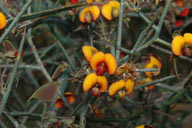In Flower This Week
A news sheet prepared by a Gardens' volunteer.
Numbers before each plant refer to temporary IFTW labels in the gardens.
Numbers in square brackets [ ] refer to garden bed Sections. Plants in flower are in bold type.
View past issues of 'In Flower This Week'.
16 September 2015
Daviesia horrida click for larger image |
We will take a short walk along the Main Path today, where there are plenty of plants in flower.
- Turn right as you exit the Visitor Information Centre (VIC) to see on your right Platytheca galioides [Section 221], with fine green foliage and deep purple bell flowers. This plant is native to southwestern Western Australia.
- Also on your right is Grevillea rosmarinifolia ‘Scarlet Sprite’ [Section 174] with fine green linear foliage and red spider flowers.
- Further on your right is Acacia gordonii [Section 174], a small shrub with fine, close dark green foliage and bright golden balls of flowers. In the wild this plant is restricted to north-west of Sydney and is endangered.
- Chorizema cordatum [Section 174], or Heart-leaved Flame Pea, on the right in a pot is a showy plant with vivid red flowers on a weeping shrub with bright green prickly foliage. It grows naturally in the moist south western parts of Western Australia.
- On the right in a pot is Hovea asperifolia [Section 174], with grey-green linear foliage close to the stem and small purple flowers with darker centres. This plant occurs in far south-eastern New South Wales, in the Australian Capital Territory, and in eastern Victoria east from Daylesford.
- Acacia myrtifolia [Section 174] is an interesting and unusual wattle that has bright red new growth and stems with green elliptical phyllodes and cream balls of flowers. It is often called the Red-stemmed Wattle or Myrtle Wattle. It is found in all six Australian states.
- Cross the bridge and skirt past the café to see on your left Daviesia horrida [Section 245], with grey spiky linear foliage, yellow buds and small pea flowers of orange and red. This shrub is endemic to south-west Western Australia.
- Further on your left is Grevillea sericea subsp. sericea [Section 244], a small bush with light green foliage and white fluffy flowers. This plant occurs west of Sydney.
- Also on your left is Libertia paniculata [Section 244], with light green strappy foliage and small white flowers held high. This species occurs naturally on the coast and adjacent ranges from south-east Queensland to eastern Victoria.
- Epacris longifolia [Section 131], or Native Fuchsia, on your left has thin tubular red flowers with white tips on a small prickly bush. This plant from the heath family is found from the central coast of New South Wales to southern Queensland.
- Further on your right is Phebalium squamulosum subsp. lineare [Section 240], a medium shrub with dull green foliage and yellow star flowers. It is found in the wild chiefly in upper Hunter Valley of New South Wales.
- Grevillea rhyolitica subsp. rhyolitica, or Deua Flame [Section 240], on your right is a large bush with dark green foliage and bright red spider flowers. It occurs in south-eastern New South Wales.
- Turn right towards the Crosbie Morrison Building to see on your right Hibbertia empetrifolia [Section 240], a groundcover with small green leaves and wiry stems ending in yellow flowers, from south-eastern New South Wales.
- Turn right again towards the VIC to see on your left the Wee Jasper Grevillea, Grevillea iaspicula [Section 240], with bright green linear foliage and pink/cream flowers. This shrub is an endangered species endemic to southern New South Wales.
- On your left is Philotheca myoporoides [Section 240], a neat bush with dull green foliage, pink buds and white star flowers endemic to south-eastern Australia.
Rosalind Walcott
![Director of National Parks [logo]](../../../../images/dnp_90px.gif)







